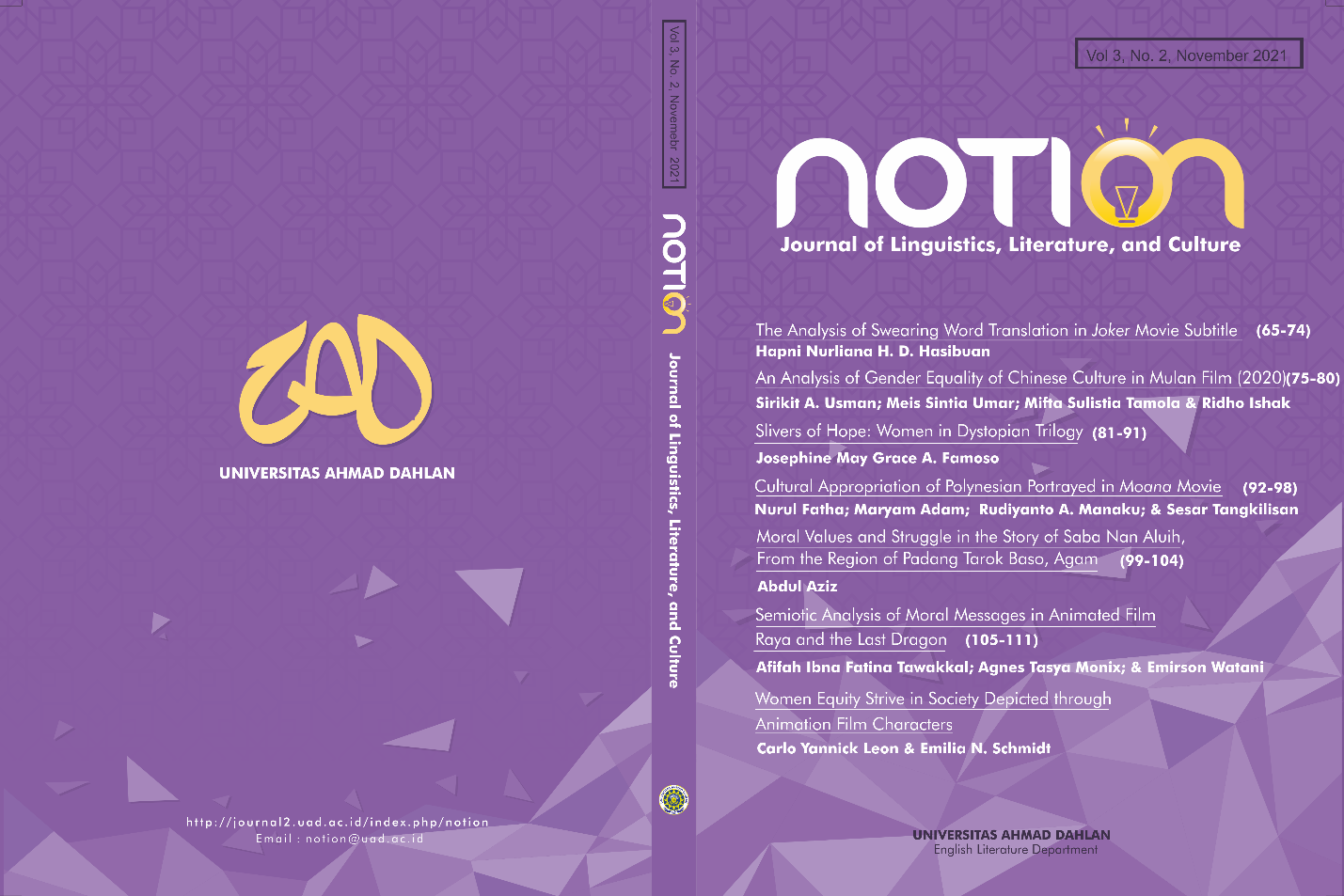Slivers of Hope: Women in Dystopian Trilogy
DOI:
https://doi.org/10.12928/notion.v3i2.4809Keywords:
Dystopia, Feminism, Hope, RevolutionAbstract
This paper explores the struggles, goals, and motivations of the women characters in The Hunger Games Trilogy. In detail, the study employs Elaine Showalter’s Feminist theory to reveal the women characters’ categories in terms of three stages: feminine, feminist and female. In the study, some of the women characters living in the dehumanized society of Panem have attained the last stage of feminism which is the female stage. However, other women characters are not able to fulfill their goals. Still, due to the women characters’ demand to change the system, they start an uprising. For example, the main character, Katniss Everdeen, contributes to the collapse of the ruling government in power as she accepts being the Mockingjay, the symbol of revolution. Another woman character to exemplify such a noble act is Johanna Mason who becomes part of the rebellion and survives the war against the unjust ruling of the Capitol. These women characters are slivers of light amidst the chaos. In conclusion, it is discovered that women characters play pivotal roles in society. This suggests that women characters recognize their power to accelerate societal advancement. For this dystopian trilogy, in particular, women become symbols of hope.
References
Beltran, M. (2021, April 26). How a Community Pantry Sparked Movement of Mutual Aid in the Philippines. The News Lens International Edition. https://international.thenewslens.com/article/149976
Bernardo, A. B. (2010). Extending hope theory: Internal and external locus of trait hope. Personality and Individual Differences, 49(8), 944–949. https://doi.org/10.1016/j.paid.2010.07.036
Coleman, R., & Ferreday, D. (2010). Introduction: Hope and Feminist Theory. Journal for Cultural Research, 14(4), 313–321. https://doi.org/10.1080/14797581003765283
Collins, S. (2008). The Hunger Games (Book 1) (Reprint ed.). Scholastic Press.
Collins, S. (2009). Catching Fire (Hunger Games2) (Reprint ed.). Scholastic Press.
Collins, S. (2010). Mockingjay (Hunger Games) (1st ed.). Scholastic Press.
Ertsgaard, G. (2021). Peeta’s Virtue in the Hunger Games Trilogy. Journal of Feminist Scholarship, 18(18). https://doi.org/10.23860/jfs.2021.18.07
Hansen, K. S. (2015). The Metamorphosis of Katniss Everdeen: The Hunger Games, Myth, and Femininity. Children’s Literature Association Quarterly, 40(2), 161–178. https://doi.org/10.1353/chq.2015.0020
Kang jun-young, et al. (2017). The De-Chinization Policy of Tsai Ing-wen and Influence on Cross-Straight Relations. (54), 389–412. https://doi.org/10.35221/tamla.2017..54.013
Klapisch, C. (1995). Feminine identity and mass consumption: A semiotic analysis of feminine products packaging. Semiotica, 104(1–2). https://doi.org/10.1515/semi.1995.104.1-2.99
Kolb, D. (2021). Adaptive leadership: The case of Jacinda Ardern and New Zealand. Academia Letters, 1–4. https://doi.org/10.20935/al557
Hawthorne, N. (1992). Scarlet Letter (Wordsworth Classics) (Reprint ed.). Wordsworth Editions Ltd.
Nehere, K. (2016). The Feminist Views: A Review. Feminist Research, 1(1), 3–20. https://doi.org/10.21523/gcj2.16010101
Oliver, K. (2014). Ambiguity, Ambivalence and Extravagance in The Hunger Games. Humanities, 3(4), 675–686. https://doi.org/10.3390/h3040675
Rigaud, S. (2013). https://www.app.pan.pl/article/item/app20120056.html. Acta Palaeontologica Polonica. Published. https://doi.org/10.4202/app.2012.0056
Showalter, E. (1999). Elaine Showalter. The Lancet, 354(9176), 438. https://doi.org/10.1016/s0140-6736(05)75868-2
Simmons, A. M. (2012). Class on Fire: Using the Hunger Games Trilogy to Encourage Social Action. Journal of Adolescent & Adult Literacy, 56(1), 22–34. https://doi.org/10.1002/jaal.00099
Smith, N. (2005). Hope and Critical Theory. Critical Horizons, 6(1), 45–61. https://doi.org/10.1163/156851605775009528
Thaler, M. (2017). Hope Abjuring Hope: On the Place of Utopia in Realist Political Theory. Political Theory, 46(5), 671–697. https://doi.org/10.1177/0090591717740324
Downloads
Published
Issue
Section
License
Copyright (c) 2021 Josephine May Grace Aclan Famoso

This work is licensed under a Creative Commons Attribution 4.0 International License.
Authors who publish their articles in NOTION: journal of Linguistics, Literature, and Culture agree to the following terms:
- Authors retain the copyright and grant the journal right of first publication with the work simultaneously licensed under a Creative Commons Attribution 4.0 International License that allows others to share the work with an acknowledgement of the work's authorship and initial publication in this journal.
- Authors are able to enter into separate, additional contractual arrangements for the non-exclusive distribution of the journal's published version of the work (e.g., post it to an institutional repository or publish it in a book), with an acknowledgement of its initial publication in this journal.
- Authors are permitted and encouraged to post their work online (e.g., in institutional repositories or on their website) prior to and during the submission process, as it can lead to productive exchanges, as well as earlier and greater citation of published work.





